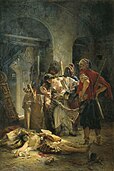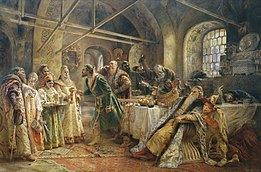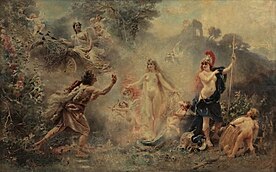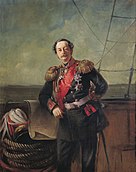| Konstantin Makovsky | |
|---|---|
 Makovsky, 1900s Makovsky, 1900s | |
| Born | Konstantin Yegorovich Makovsky (1839-06-20)20 June 1839 Moscow, Moskovsky Uyezd, Moscow Governorate, Russian Empire |
| Died | 17 September 1915(1915-09-17) (aged 76) Petrograd, Russian Empire |
| Resting place | Nikolskoe Cemetery, St. Petersburg (lost) |
| Alma mater | Moscow School of Painting, Sculpture and Architecture Imperial Academy of Arts |
| Known for | Painting |
| Movement | Peredvizhniki, Academism |
| Awards | Member Academy of Arts (1867) Full Member Academy of Arts (1898) |
| Patron(s) | Alexander II of Russia |
Konstantin Yegorovich Makovsky (Russian: Константи́н Его́рович Мако́вский; (20 June o.c.) 2 July n.c. 1839 – 17 o.c. (30 n.c.) September 1915) was an influential Russian painter, affiliated with the "Peredvizhniki (Wanderers)". Many of his historical paintings, such as Beneath the Crown (1889) also known as The Russian Bride's Attire and Before the Wedding, showed an idealized view of Russian life of prior centuries. He is often considered a representative of Academic art.
Biography
Konstantin Makovsky (1839–1915) was a famous Russian realist painter who opposed academic restrictions that existed in the art world at the time. His father was the Russian art figure and amateur painter, Egor Makovsky and his mother was a composer. Because of his parents' professions, Makovsky showed an early interest in painting and music. He entered the Moscow School of Painting, Sculpture and Architecture at the age of 12, where he was influenced by teachers such as Vasily Tropinin and Karl Bryullov. After graduating, Makovsky went to France in hopes of becoming a composer, but after touring Europe in order to get acquainted with traditional folk and classical music, he ultimately chose painting.
In 1858 Makovsky entered the Imperial Academy of Arts in Saint Petersburg, where he created artworks such as Curing of the Blind (1860) and Agents of the False Dmitry kill the son of Boris Godunov (1862). In 1863, Makovsky and thirteen other students protested against the Academy's decision to only allow artwork of Scandinavian mythology in the competition for the Large Gold Medal of Academia. Thus, all of them left the academy without a diploma. This incident later came to be known as the "Revolt of the Fourteen".
Later, Makovsky joined the Artel of Artists, a cooperative association founded by Ivan Kramskoi, whose members were realist artists that advocated for more realistic depictions of the everyday life of old Russia. Notable works by Makovsky of this period are "The Widow" (1865) and "The Herringwoman" (1867). In 1870 he became a founding member of the Society for Travelling Art Exhibitions and continued to work on paintings in the realism genre. He went on to travel North Africa and Serbia in the mid-1870s., which resulted in a significant stylistic change as he started putting greater emphasis on colours and shapes.
At the World's Fair of 1889 in Paris, he received the Large Gold Medal for his paintings Death of Ivan the Terrible, The Judgement of Paris, and Demon and Tamara. By the end of the century, Makovsky was one of the most respected and highly-paid Russian artists, regarded by some critics as the forerunner of Russian impressionism. He died in 1915 when his crew crashed into a tram on the streets of St. Petersburg.
Artist's style
The artist's painterly style has the features of several styles. Having left school and being a representative of academism, he demonstrated some of the qualities which would be most clearly shown in the work of the Russian Impressionists. In addition, some of his historical paintings, such as Bride-show (1889), show an idealised view of life in Russia in previous eras.
Artworks
-
 A Boyar Wedding Feast
A Boyar Wedding Feast
-
 The Bulgarian martyresses
The Bulgarian martyresses
-
 Kissing Ceremony
Kissing Ceremony
-
 Beneath the Crown/The Russian Bride's Attire/Before the Wedding
Beneath the Crown/The Russian Bride's Attire/Before the Wedding
-
 Bride-show
Bride-show
-
 The Murder of False Dmitry
The Murder of False Dmitry
-
 The Toilet of Venus
The Toilet of Venus
-
 Happy Arcadia
Happy Arcadia
-
 The Judgement of Paris
The Judgement of Paris
-
 Self-Portrait, c. 1856
Self-Portrait, c. 1856
-
 Portrait of S. L. Stroganova
Portrait of S. L. Stroganova
-
 Portrait of Sergei Stroganov
Portrait of Sergei Stroganov
-
 Portrait of Muraviev-Amursky
Portrait of Muraviev-Amursky
-
 Tsar Alexander II
Tsar Alexander II
-
 Christmastide Divination. Historic paintings of Russian peasant life made Konstantin Makovsky popular in Russia
Christmastide Divination. Historic paintings of Russian peasant life made Konstantin Makovsky popular in Russia
-
 Children of the Artist, 1882
Children of the Artist, 1882
-
 Ophelia
Ophelia
See also
References
- Andrey Somov (1890–1907). "Маковский". Brockhaus and Efron Encyclopedic Dictionary: In 86 Volumes (82 Volumes and 4 Additional Volumes) (in Russian). St. Petersburg: F. A. Brockhaus.
- ^ "Makovsky Konstantin Egorovich, artist". Krasnoselsky district of Moscow. Retrieved 22 October 2021.
- ^ "Biography of Konstantin Makovsky". blouinartinfo.com. Blouin Media. Archived from the original on 6 March 2019.
- "Особенности реализма в России". philol.msu.ru (in Russian). Faculty of Philology, Moscow State University. Archived from the original on 11 August 2020.
Further reading
- Makovsky, Sergey K. (2000). "Отец и моё детство". Портреты современников (in Russian). Moscow: Agraf. pp. 9–70. ISBN 5-7784-0099-3.
External links
- Biography on site Hrono.ru (in Russian)
- Official site (in Russian)
- Biography on site gelos.ru Archived 2 December 2016 at the Wayback Machine (in Russian)
- Biography (in Russian)
- Members of the Imperial Academy of Arts
- Full Members of the Imperial Academy of Arts
- 1839 births
- 1915 deaths
- Painters from Moscow
- People from Moskovsky Uyezd
- Peredvizhniki
- 19th-century painters from the Russian Empire
- 20th-century Russian painters
- Orientalist painters from the Russian Empire
- Portrait painters from the Russian Empire
- Male painters from the Russian Empire
- Imperial Academy of Arts alumni
- Burials at Nikolskoe Cemetery
- 19th-century male artists from the Russian Empire
- 20th-century Russian male artists
- Moscow School of Painting, Sculpture and Architecture alumni
- Residents of the Benois House